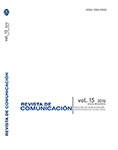
Vol. XV
2016
Author:
Alberto López-Hermida Russo. http://orcid.org/0000-0002-6446-8273
María Fernanda Vallejo Hicil
References
Alexander, D. & Andersen, K. (1993). Gender as a Factor in the Attribution of Leadership Traits. Political Research Quarterly, 46(3), 527-545.
Argamon, S.; Koppel, M.; Fine, J. & Shimoni, A. (2003). Gender, genre, and writing style in formal written texts. Text, 23(3), 321-346.
Banwart, M. (2010). Gender and Candidate Communication: Effects of Stereotypes in the 2008 Election. American Behavioral Scientist, 54(3), 265-283.
Burrel, B. (2004). Women and Political Participation: A Reference Handbook. Santa Barbara: ABC-CLIO.
Cunha, E.; Magno, G.; Comarela, G.; Almeida, V.; Gonçalves, M. (2011). Analyzing the dynamic evolution of hashtags on Twitter: A language-based approach. Proceedings of the Workshop on Language in Social Media, 58-65.
Delli Carpini, M. (2000). GenCom: Youth, civic engagement, and the new information environment”. Political Communication, 17(4), 341-349.
Fridkin, K. (1993). Gender differences in campaign messages: The political advertisements of men and women candidates for U.S. Senate. Political Research Quarterly, 43 (3), 481-502.
Hirzalla, F., & Van Zoonen, L.(2011). Beyond the Online/Offline Divide. Convergence of Online and Offline Civic Activities among Youth. Social Science Compute Review, 29 (4), 481-498.
Huddy, L. & Terkildsen, N. (1993a). Gender Stereotypes and the Perception of Male and Female Candidates. American Journal of Political Science, 37 (1), 119-147.
Huddy, L. & Terkilsen, N. (1993b). The consequences of gender stereotypes for women candidates at different levels and types of office. Political Research Quarterly, 46 (3), 503-525.
Iyengar, S.; Valentino, N.; Ansolabehere, S. & Simon, A. (1997). Running as a woman: Gender stereotyping in political campaigns. En: Norris, Pippa (ed.). Women, Media, and Politics. New York: Oxford University Press.
Locksley, A.; Borgida, E.; Brekke, N. & Hepburn, C. (1980). Sex stereotypes and social judgment. Journal of Personality and Social Psychology, 39 (5), 821-831.
López-Hermida, A. (2006). Mujeres al poder: la reivindicación de los estereotipos. Nuevas Tendencias, 62, 3-14.
López-Hermida, A. (2007). El estereotipo de género en política. La imagen de la mujer candidata en las elecciones presidenciales chilenas 2005-06 y su continuidad en el primer año de gobierno de Michelle Bachelet. Tesis doctoral inédita. Universidad de Navarra. Pamplona, España.
López-Hermida, A. (2009). La imagen de la mujer en política: campaña electoral televisiva de Michelle Bachelet. Cuadernos de Información, 24(1), 5-16.
López-Hermida, A. (2011). Mujer y política desde la triangulación metodológica. Análisis de contenido de la campaña presidencial y del discurso de los medios durante el primer año de gobierno de la presidenta chilena Michelle Bachelet. Revista Chilena de Comunicación, 2, 63-79.
López-Hermida, A. (2013). El estereotipo de género como factor estratégico: comunicación política sin corbata. En Sanders, K. et al. Hacia una Profesionalización de la Comunicación Política en México. Retos y desafíos para conformar gobiernos cercanos a la sociedad. MAPorrúa, México, 57-113.
López-Hermida, A. y Cerda, F. (2012). Women and Politics: The privacy without necktie. Revista de Comunicación, 11, 196-211.
Montgomery, B. & Norton, R. (1981). Sex differences and similarities in communicator style. Communication Monographs, 48 (2), 121-132.
Rule, W. (1981). Why women don’t run: The critical contextual factors in women’s legislative recruitment. The Western Political Quarterly, 34 (1), 60-77.
Sanbonmatsu, K. (2002). Gender Stereotypes and Vote Choice. American Journal of Political Science, 46 (1), 20-34.
Trent, J. & Friedenberg, R. (1995). Political Campaign Communication: Principles and Practices. Preager: Westport.
Trent, J. & Sabourin, T. (1993). Sex still counts: Women’s use of televised advertising during the decade of the 80’s. Journal of Applied Communication Research, 21 (1), 21-40.
Vergeer, M.; Hermans, L. & Sams, S. (2011). Online social networks and micro-blogging in political campaigning. Party Politics 19(3), 477-501.
Zamora, R. & Zurutuza, C. (2014). Campaigning on Twitter: Towards the ‘Personal Style’ Campaign to Activate the Political Engagement During the 2011 Spanish General Elections. Comunicación y Sociedad. 27(1), 83 -106.
up
